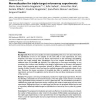Free Online Productivity Tools
i2Speak
i2Symbol
i2OCR
iTex2Img
iWeb2Print
iWeb2Shot
i2Type
iPdf2Split
iPdf2Merge
i2Bopomofo
i2Arabic
i2Style
i2Image
i2PDF
iLatex2Rtf
Sci2ools
BMCBI
2008
2008
Normalization for triple-target microarray experiments
Background: Most microarray studies are made using labelling with one or two dyes which allows the hybridization of one or two samples on the same slide. In such experiments, the most frequently used dyes are Cy3 and Cy5. Recent improvements in the technology (dye-labelling, scanner and, image analysis) allow hybridization up to four samples simultaneously. The two additional dyes are Alexa488 and Alexa494. The triple-target or four-target technology is very promising, since it allows more flexibility in the design of experiments, an increase in the statistical power when comparing gene expressions induced by different conditions and a scaled down number of slides. However, there have been few methods proposed for statistical analysis of such data. Moreover the lowess correction of the global dye effect is available for only two-color experiments, and even if its application can be derived, it does not allow simultaneous correction of the raw data. Results: We propose a two-step norma...
| Added | 08 Dec 2010 |
| Updated | 08 Dec 2010 |
| Type | Journal |
| Year | 2008 |
| Where | BMCBI |
| Authors | Marie-Laure Martin-Magniette, Julie Aubert, Avner Bar-Hen, Samira Elftieh, Frederic Magniette, Jean-Pierre Renou, Jean-Jacques Daudin |
Comments (0)

